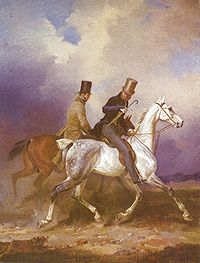
Franz Krüger
Encyclopedia
Franz Krüger known as Pferde-Krüger, was a German (Prussian) painter and lithographer.
 He was best known for his romantic and lively portraits and pictures of horses, which made him the most in demand military and portrait painter in Berlin. His paintings of military parades and hundreds of portraits led to him painting many of the "well to do" of the city.
He was best known for his romantic and lively portraits and pictures of horses, which made him the most in demand military and portrait painter in Berlin. His paintings of military parades and hundreds of portraits led to him painting many of the "well to do" of the city.
from the neighbouring town of Ziebigk led him into animal paintings. During his schooldays in Dessau, he came into contact with the landscape painter Karl Kolbe the elder. Krüger studied from 1812-1813 at the art academy of Berlin and later tried his own hand at nature painting. In 1818, his military paintings were exhibited in the art academy for the first time. His portrait of Prince August of Prussia (a son of Prince Augustus Ferdinand of Prussia) and Lord Neidhardt von Gneisenau lay the foundations for his fame as a portrait artist, and also led to further works of the royal family. In 1825, he was named as Royal Professor, and part of the Art Academy. Many trips to the Russian Tsar Palace in St. Petersburg and the castles in Hannover and Schwerin
followed. During a study trip to Paris
in 1846, he met Eugène Delacroix
. After the revolutions of 1848
, he returned to Dessau, but in 1855, he took part in the World Exhibition in Paris.
In 1825, he married an artist called Johanna Eunicke. She died in 1856. He died the year after, and was buried at Dorotheenstädtisch-Friedrichswerderscher Friedhof in Berlin.
One of his students was the animal painter Carl Steffeck.

Life
Krüger was the son of a nobleman, and his friendship with the ornithologist Johann Friedrich NaumannJohann Friedrich Naumann
Johann Friedrich Naumann was a German scientist and editor.Naumann is regarded as the founder of scientific ornithology in Europe...
from the neighbouring town of Ziebigk led him into animal paintings. During his schooldays in Dessau, he came into contact with the landscape painter Karl Kolbe the elder. Krüger studied from 1812-1813 at the art academy of Berlin and later tried his own hand at nature painting. In 1818, his military paintings were exhibited in the art academy for the first time. His portrait of Prince August of Prussia (a son of Prince Augustus Ferdinand of Prussia) and Lord Neidhardt von Gneisenau lay the foundations for his fame as a portrait artist, and also led to further works of the royal family. In 1825, he was named as Royal Professor, and part of the Art Academy. Many trips to the Russian Tsar Palace in St. Petersburg and the castles in Hannover and Schwerin
Schwerin
Schwerin is the capital and second-largest city of the northern German state of Mecklenburg-Vorpommern. The population, as of end of 2009, was 95,041.-History:...
followed. During a study trip to Paris
Paris
Paris is the capital and largest city in France, situated on the river Seine, in northern France, at the heart of the Île-de-France region...
in 1846, he met Eugène Delacroix
Eugène Delacroix
Ferdinand Victor Eugène Delacroix was a French Romantic artist regarded from the outset of his career as the leader of the French Romantic school...
. After the revolutions of 1848
Revolutions of 1848
The European Revolutions of 1848, known in some countries as the Spring of Nations, Springtime of the Peoples or the Year of Revolution, were a series of political upheavals throughout Europe in 1848. It was the first Europe-wide collapse of traditional authority, but within a year reactionary...
, he returned to Dessau, but in 1855, he took part in the World Exhibition in Paris.
In 1825, he married an artist called Johanna Eunicke. She died in 1856. He died the year after, and was buried at Dorotheenstädtisch-Friedrichswerderscher Friedhof in Berlin.
One of his students was the animal painter Carl Steffeck.
Literature
- Max Osborn: Franz Krüger. Hrsg. und mit einem Vorwort von Kerstin Englert. Gebr. Mann, Berlin 1997 ISBN 3-7861-1913-9 (Neuausgabe des Buchs von 1910)

